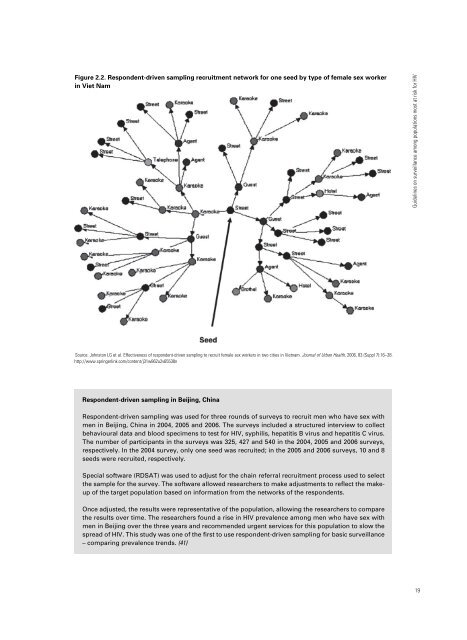Guidelines on surveillance among populations most at risk for HIV
Guidelines on surveillance among populations most at risk for HIV
Guidelines on surveillance among populations most at risk for HIV
- No tags were found...
Create successful ePaper yourself
Turn your PDF publications into a flip-book with our unique Google optimized e-Paper software.
Figure 2.2. Resp<strong>on</strong>dent-driven sampling recruitment network <strong>for</strong> <strong>on</strong>e seed by type of female sex workerin Viet Nam<str<strong>on</strong>g>Guidelines</str<strong>on</strong>g> <strong>on</strong> <strong>surveillance</strong> am<strong>on</strong>g popul<strong>at</strong>i<strong>on</strong>s <strong>most</strong> <strong>at</strong> <strong>risk</strong> <strong>for</strong> <strong>HIV</strong>Source: Johnst<strong>on</strong> LG et al. Effectiveness of resp<strong>on</strong>dent-driven sampling to recruit female sex workers in two cities in Vietnam. Journal of Urban Health, 2006, 83 (Suppl 7):16–28.http://www.springerlink.com/c<strong>on</strong>tent/j31w862u2v65538nResp<strong>on</strong>dent-driven sampling in Beijing, ChinaResp<strong>on</strong>dent-driven sampling was used <strong>for</strong> three rounds of surveys to recruit men who have sex withmen in Beijing, China in 2004, 2005 and 2006. The surveys included a structured interview to collectbehavioural d<strong>at</strong>a and blood specimens to test <strong>for</strong> <strong>HIV</strong>, syphilis, hep<strong>at</strong>itis B virus and hep<strong>at</strong>itis C virus.The number of participants in the surveys was 325, 427 and 540 in the 2004, 2005 and 2006 surveys,respectively. In the 2004 survey, <strong>on</strong>ly <strong>on</strong>e seed was recruited; in the 2005 and 2006 surveys, 10 and 8seeds were recruited, respectively.Special software (RDSAT) was used to adjust <strong>for</strong> the chain referral recruitment process used to selectthe sample <strong>for</strong> the survey. The software allowed researchers to make adjustments to reflect the makeupof the target popul<strong>at</strong>i<strong>on</strong> based <strong>on</strong> in<strong>for</strong>m<strong>at</strong>i<strong>on</strong> from the networks of the resp<strong>on</strong>dents.Once adjusted, the results were represent<strong>at</strong>ive of the popul<strong>at</strong>i<strong>on</strong>, allowing the researchers to comparethe results over time. The researchers found a rise in <strong>HIV</strong> prevalence am<strong>on</strong>g men who have sex withmen in Beijing over the three years and recommended urgent services <strong>for</strong> this popul<strong>at</strong>i<strong>on</strong> to slow thespread of <strong>HIV</strong>. This study was <strong>on</strong>e of the first to use resp<strong>on</strong>dent-driven sampling <strong>for</strong> basic <strong>surveillance</strong>– comparing prevalence trends. (41)19















